The Antennae Galaxies, also known as the Ringtail Galaxy, are a pair of colliding galaxies located in the constellation Corvus. The collision has produced two long tails of stars that resemble an insect’s antennae. The “antennae” are formed by two streamers of ejected stars, dust and gas extending far into space and giving the galaxies their common nickname.
The galaxies have the designations NGC 4038 and NGC 4039 in the New General Catalogue. They are listed as Caldwell 60 and Caldwell 61 in the Caldwell catalogue of deep sky objects that can be observed in amateur telescopes and have the designation Arp 244 in American astronomer Halton Arp’s 1966 Atlas of Peculiar Galaxies.
The interacting spiral galaxies have apparent magnitudes of 11.2 and 11.1 and lie approximately 45 and 65 million light-years away. They appear in the same region of the sky as Spica’s Spanker, an asterism formed by the brightest stars in the Corvus constellation.
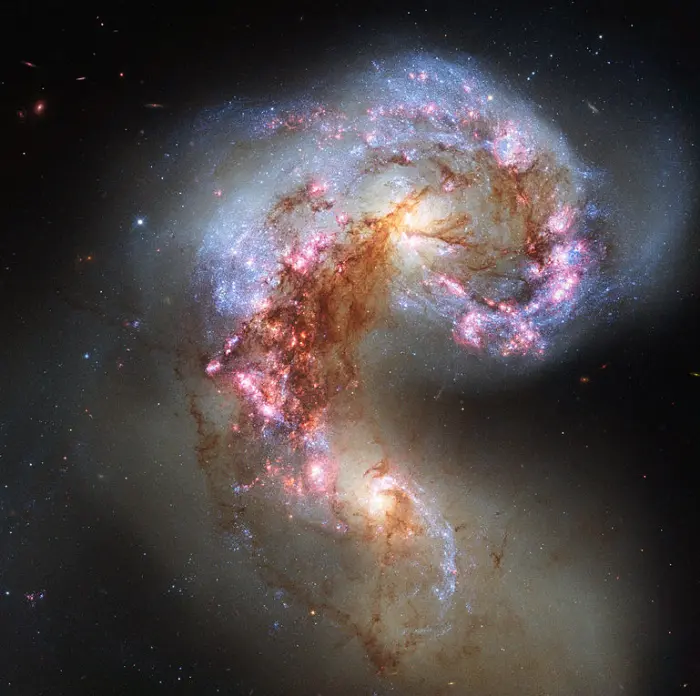
The NASA/ESA Hubble Space Telescope has snapped the best ever image of the Antennae Galaxies. Hubble has released images of these stunning galaxies twice before, once using observations from its Wide Field and Planetary Camera 2 (WFPC2) in 1997, and again in 2006 from the Advanced Camera for Surveys (ACS). Each of Hubble’s images of the Antennae Galaxies has been better than the last, due to upgrades made during the famous servicing missions, the last of which took place in 2009. Once normal, sedate spiral galaxies like the Milky Way, the pair have spent the past few hundred million years sparring with one another. This clash is so intense that stars have been ripped from their host galaxies to form a streaming arc between the two. In wide-field images of the pair the reason for their name becomes clear — far-flung stars and streamers of gas stretch out into space, creating long tidal tails reminiscent of antennae. This new image of the Antennae Galaxies shows obvious signs of chaos. Clouds of gas are seen in bright pink and red, surrounding the bright flashes of blue star-forming regions — some of which are partially obscured by dark patches of dust. The rate of star formation is so high that the Antennae Galaxies are said to be in a state of starburst, a period in which all of the gas within the galaxies is being used to form stars. This cannot last forever and neither can the separate galaxies; eventually the nuclei will coalesce, and the galaxies will begin their retirement together as one large elliptical galaxy. This image uses visible and near-infrared observations from Hubble’s Wide Field Camera 3 (WFC3), along with some of the previously-released observations from Hubble’s Advanced Camera for Surveys (ACS). Image credit: ESA/Hubble & NASA (CC BY 4.0)
The Antennae Galaxies are one of the youngest examples of colliding galaxies, as well as one of the nearest pairs of interacting galaxies to Earth. The merging galaxies reveal a likely future of the Milky Way when it collides with the neighbouring Andromeda Galaxy (Messier 31) in several billion years.
NGC 4038 and NGC 4039 are going through a phase of intense starburst activity. Their colliding clouds of dust and gas compress massive molecular clouds and cause the rapid formation of millions of new stars. Many of these young stars are gravitationally bound and form massive clusters.
Astronomers have discovered more than a thousand bright clusters consisting of newly formed stars in the Antennae. The brightest and most compact starburst regions contain super star clusters. Before the galactic collision is over, billions more new stars will be formed in the galaxies.
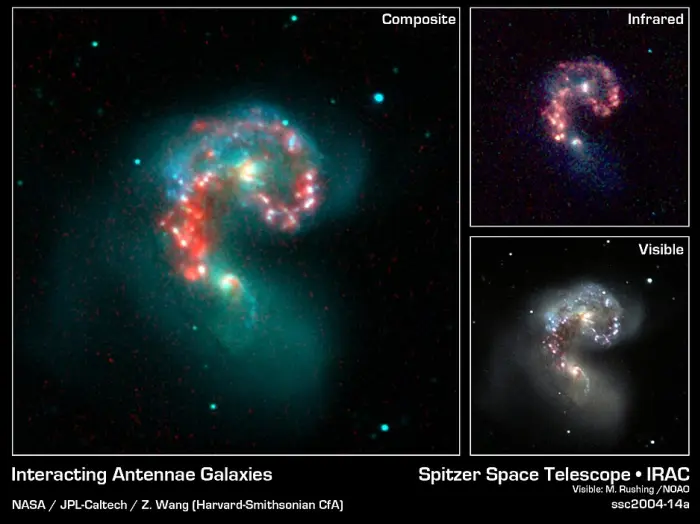
This false-color image from NASA’s Spitzer Space Telescope reveals hidden populations of newborn stars at the heart of the colliding “Antennae” galaxies. The Spitzer observations provide a snapshot of the tremendous burst of star formation triggered in the process of this collision, particularly at the site where the two galaxies overlap. The main image is a false-color composite of infrared data from Spitzer and visible-light data from Kitt Peak National Observatory, Tucson, Ariz. Visible light from stars in the galaxies (blue and green) is shown together with infrared light from warm dust clouds heated by newborn stars (red). The two nuclei, or centers, of the merging galaxies show up as yellow-white areas, one above the other. The brightest clouds of forming stars lie in the overlap region between and left of the nuclei. The upper right panel shows the Spitzer image by itself. This picture was taken by the infrared array camera and is a combination of infrared light ranging from 3.6 microns (shown in blue) to 8.0 microns (shown in red). The dust emission (red) is by far the strongest feature in this image. Starlight was systematically subtracted from the longer wavelength data (red) to enhance dust features. The lower right panel shows the true-color, visible-light image by itself. Here, we find a strikingly different view, with the bright star-forming features seen in the Spitzer image embedded within dark clouds of dust. Image credit: NASA/JPL-Caltech/Z. Wang (Harvard-Smithsonian CfA); Visible: M. Rushing/NOAO
NGC 4038 and NGC 4039 also host massive globular clusters that may have formed as a result of the galactic merger. These clusters are much younger than most known globular clusters. They are believed to have formed in the densest regions of compressed molecular clouds within the galaxies.
Most of the super star clusters formed in the Antennae will disperse within the first 10 million years. Astronomers have predicted that only 10 percent of these clusters will last longer. Roughly a hundred of the most massive ones will survive to eventually form regular globular clusters, similar to those found in our galaxy, the Milky Way.
NGC 4038 and NGC 4039 were two separate galaxies some 1.2 billion years ago. NGC 4039, the larger of the two, was a spiral galaxy, while NGC 4038 was a barred spiral galaxy. The two galaxies started approaching each other roughly 900 million years ago. At this point, the pair appeared similar to the colliding spiral galaxies NGC 2207 and IC 2163 located in the Canis Major constellation.
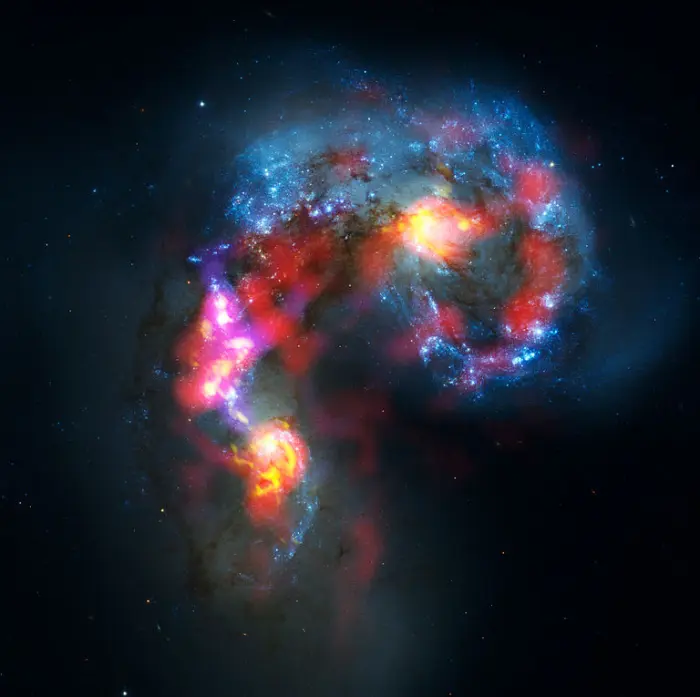
The Antennae Galaxies (also known as NGC 4038 and 4039) are a pair of distorted colliding spiral galaxies in the constellation of Corvus (the Crow). This view combines ALMA observations, made in two different wavelength ranges during the observatory’s early testing phase, with visible-light observations from the NASA/ESA Hubble Space Telescope. Image credit: ALMA (ESO/NAOJ/NRAO). Visible light image: the NASA/ESA Hubble Space Telescope
The Antennae Galaxies are believed to have passed through each other about 600 million years ago, when they may have appeared similar to the Mice Galaxies (NGC 4676), a pair of interacting spiral galaxies in the constellation Coma Berenices.
300 million years later, the stars in both galaxies started being released into intergalactic space. As a result, there are now two trails of expelled stars extending far beyond NGC 4038 and NGC 4039, producing the antennae shape.
The Antennae Galaxies’ nuclei are in the process of joining to form a single larger galaxy. This will happen within the next 400 million years. Simulations of the galactic collision indicate that as the galaxies’ nuclei join to form a single core, the two galaxies will eventually form a single giant elliptical galaxy.
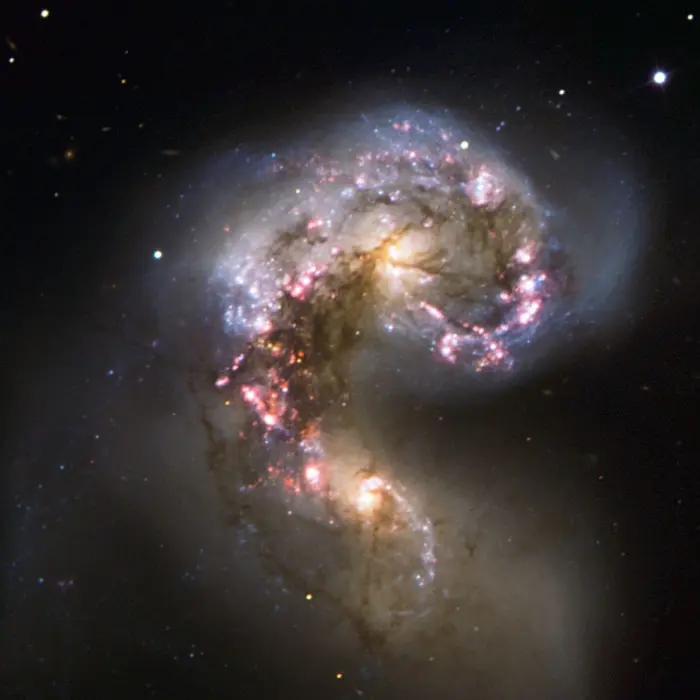
A Very Large Telescope (VLT) image of the Antennae Galaxies gives us what may be the second-best visible-light view yet of this striking pair of colliding galaxies with dramatically distorted shapes. This amazing object takes its name from the long antenna-like “arms” extending far out from the nuclei of the two galaxies, best seen in wider-field images by ground-based telescopes such as the one at this link. This VLT view focuses instead on the galaxies’ nuclei, where the real action is taking place as the two galaxies merge into a single giant galaxy. Spurred by shock waves created by their gravitational wrestling, the two galaxies have become dotted with brilliant blue hot young stars in star-forming regions, surrounded by glowing hydrogen gas, shown here in pink. The two pale yellow blobs are the cores of the original galaxies, shining with the light of old stars and picked out by delicate lanes of dust. The Antennae Galaxies were immortalised in 2006 by one of the NASA/ESA Hubble Space Telescope’s most famous images (composed by ESA’s Hubble group residing at ESO). Image: ESO
NGC 4038 and NGC 4039 are passing through each other at a very high speed, at hundreds of kilometres per second. The reason why the galactic merger is taking hundreds of millions of years to complete is the enormous size of the galaxies.
The galaxies’ tidal tails were formed 200 to 300 million years ago, during the galaxies’ first encounter. As the galaxies collided and passed through each other, some of their stars, dust and gas were drawn out into long tails of material. The two tails will eventually either fall back into the newly formed elliptical galaxy or be lost to space.
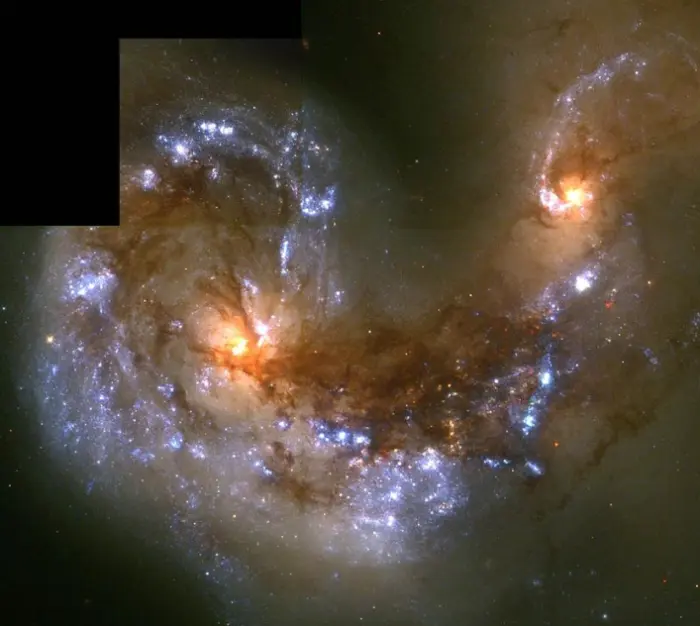
This Hubble Space Telescope image provides a detailed look at a brilliant “fireworks show” at the center of a collision between two galaxies. Hubble has uncovered over 1,000 bright, young star clusters bursting to life as a result of the head-on collision. The respective cores of the twin galaxies are the orange blobs, left and right of image center, crisscrossed by filaments of dark dust. A wide band of chaotic dust, called the overlap region, stretches between the cores of the two galaxies. The sweeping spiral- like patterns, traced by bright blue star clusters, shows the result of a firestorm of star birth activity which was triggered by the collision.
This natural-color image is a composite of four separately filtered images taken with the Wide Field Planetary Camera 2 (WFPC2), on January 20, 1996. Resolution is 15 light-years per pixel (picture element).
Image credit: NASA/ESA/HST Brad Whitmore (HST)
The Antennae Galaxies were imaged by NASA and ESA’s Hubble Space Telescope (HST) in 1997 and 2006. The 1997 image was taken with the Wide Field and Planetary Camera 2 (WFPC2) and the one taken in 2006 was captured with the Advanced Camera for Surveys (ACS). An image released in 2013 combined observations in the visible, ultraviolet, and infrared wavelengths made with Hubble’s Wide Field Camera 3 with the data previously obtained with the Advanced Camera for Surveys.
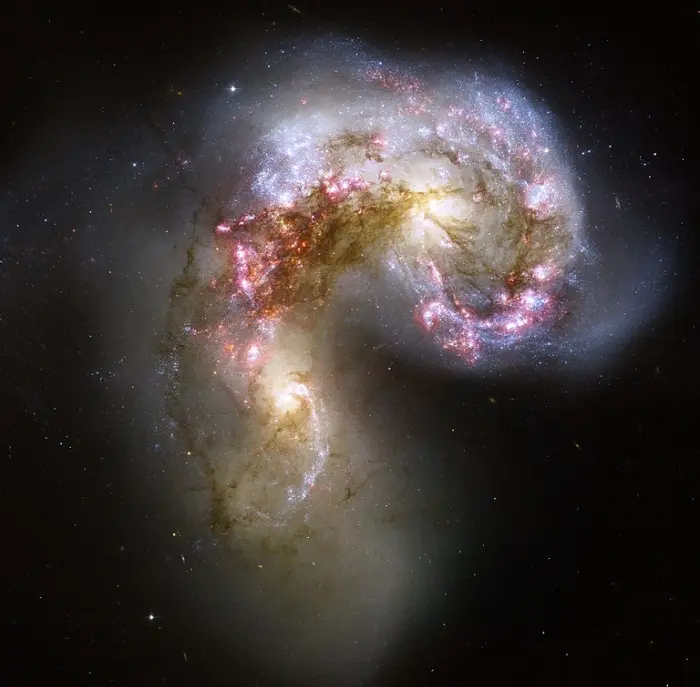
Antennae Galaxies – The two spiral galaxies started to interact a few hundred million years ago, making the Antennae galaxies one of the nearest and youngest examples of a pair of colliding galaxies. Nearly half of the faint objects in the Antennae image are young clusters containing tens of thousands of stars. The orange blobs to the left and right of image center are the two cores of the original galaxies and consist mainly of old stars criss-crossed by filaments of dust, which appear brown in the image. The two galaxies are dotted with brilliant blue star-forming regions surrounded by glowing hydrogen gas, appearing in the image in pink. Image: NASA, ESA, and the Hubble Heritage Team (STScI/AURA)-ESA/Hubble Collaboration
Facts
The Antennae Galaxies were discovered by the German-born British astronomer Sir William Herschel on February 7, 1785. They were initially classified as a planetary nebula.
William Herschel’s son John catalogued the galaxies as h 1052 and h 1053 in his 1833 catalogue. He later listed them as GC 2670 and GC 2671 in his General Catalogue of 1864. Danish astronomer John Louis Emil Dreyer included the galaxies as NGC 4038 and NGC 4039 in the New General Catalogue.
The Antennae Galaxies are members of the NGC 4038 Group. The group contains between 13 and 27 member galaxies. The brightest members also include the unbarred spiral galaxy NGC 3981, the barred spiral NGC 4027, and the elliptical galaxy NGC 4033. The NGC 4038 Group is part of the Virgo Supercluster, which also contains the Local Group, the home of the Milky Way galaxy.
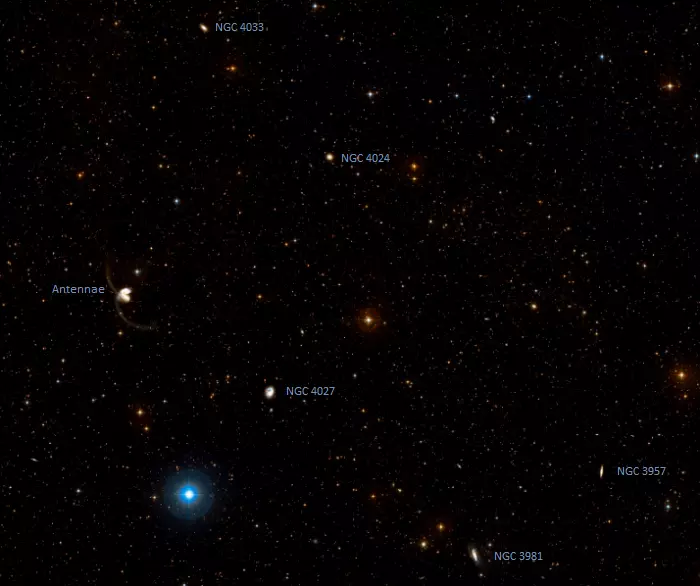
NGC 4038 Group, image: Wikisky
The Antennae were among the galactic pairs used to model the collision and merger sequence for galaxy evolution in the 1970s. The first simulations of galaxy mergers were conducted by American astronomer and mathematician Alar Toomre and his brother Jüri, an astrophysicist. They used the Antennae, Arp 295 in the constellation Aquarius, the Whirlpool Galaxy (Messier 51) and NGC 5195 in Canes Venatici, and the Mice Galaxies (NGC 4676) in Coma Berenices to create the models. The collision and merger sequence is known as the Toomre sequence.
Five supernovae have been observed in the Antennae Galaxies: SN 1921A in 1921, SN 1974E in 1974, SN 2004GT in 2004, SN 2007sr in 2007, and SN 2013dk in 2013.
SN 1921A was discovered by American astronomers Edwin Hubble and John C. Duncan in NGC 4039 on March 1, 1921. It peaked at magnitude 16.0 on March 7. SN 1974E was a type II supernova discovered by Hungarian astronomer Miklós Lovas on March 21, 1974. It occurred in NGC 4038 and peaked at magnitude 14.0.
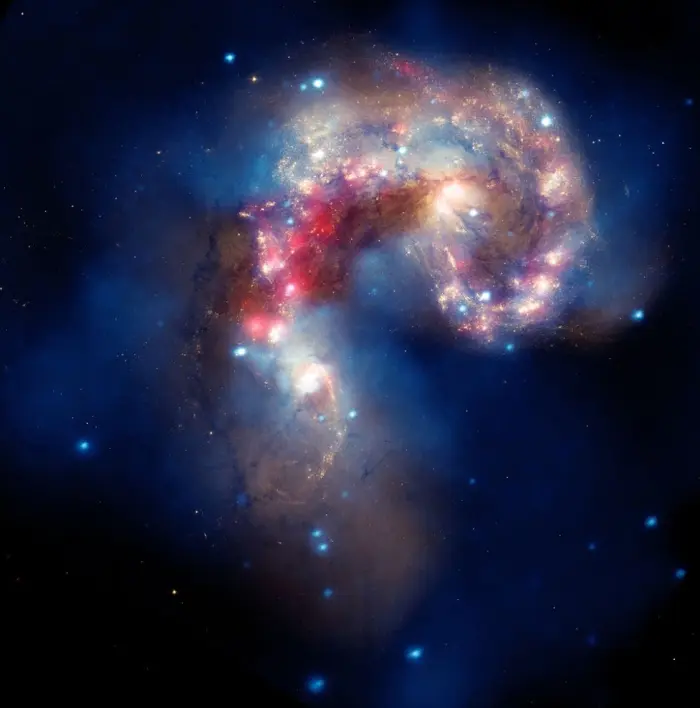
A beautiful image of two colliding galaxies has been released by NASA’s Great Observatories. The Antennae Galaxies are shown in this composite image from the Chandra X-ray Observatory (blue), the Hubble Space Telescope (gold and brown), and the Spitzer Space Telescope (red). The Antennae Galaxies take their name from the long antenna-like “arms,” seen in wide-angle views of the system. These features were produced by tidal forces generated in the collision. The collision, which began more than 100 million years ago and is still occurring, has triggered the formation of millions of stars in clouds of dust and gas in the galaxies. The most massive of these young stars have already sped through their evolution in a few million years and went out as supernovae. The X-ray image from Chandra shows huge clouds of hot, interstellar gas that have been injected with rich deposits of elements from supernova events. This enriched gas, which includes elements such as oxygen, iron, magnesium, and silicon, will be incorporated into new generations of stars and planets. The bright, point-like sources in the image are produced by material falling onto black holes and neutron stars that are remnants of the massive stars. Some of these black holes may have masses that are almost one hundred times that of the Sun. The Spitzer data show infrared light from warm dust clouds that have been heated by newborn stars, with the brightest clouds lying in the overlapping region between the two galaxies. The Hubble data reveal old stars and star-forming regions in gold and white, while filaments of dust appear in brown. Many of the fainter objects in the optical image are clusters containing thousands of stars. The Chandra image was taken in December 1999. The Spitzer image was taken in December 2003. The Hubble image was taken in July 2004 and February 2005. Image: NASA, ESA, SAO, CXC, JPL-Caltech, and STScI
SN 2004GT was classified as a type Ic supernova. It occurred in the western spiral arm of NGC 4038 on December 12, 2004, and peaked at magnitude 14.7. The progenitor star is believed to have been either a Wolf-Rayet star over 40 times more massive than the Sun or a star with a mass of 20 – 40 solar masses that was part of a binary system.
SN 2007sr was a type I supernova that occurred in NGC 4038 on December 7, 2007. It peaked at magnitude 12.7 five days later. SN 2013dk was classified as a type Ic supernova. It was spotted in NGC 4038 and had an apparent magnitude of 15.8 at the time of discovery.
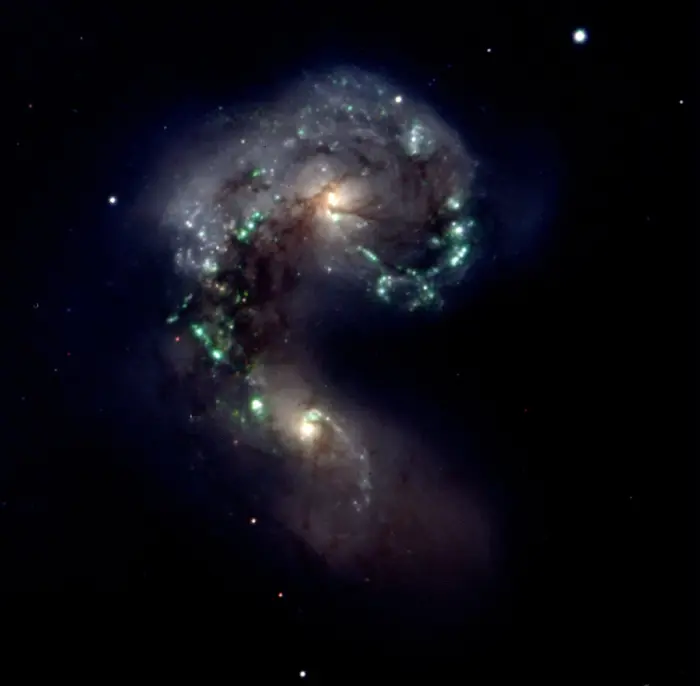
One of the first images from the VIMOS facility, obtained right after the moment of “first light” on Ferbruary 26, 2002. It shows the famous “Antennae Galaxies” (NGC 4038/9), the result of a recent collision between two galaxies. Image: ESO
A Chandra X-ray Observatory study of the Antennae Galaxies has revealed that the galaxies contain considerable amounts of elements necessary for the formation of habitable planets, including magnesium, neon, and silicon.
The distance between the galaxies’ centres is estimated to be around 30,000 light years. The nuclei of NGC 4038 and NGC 4039 are believed to contain mostly old stars.
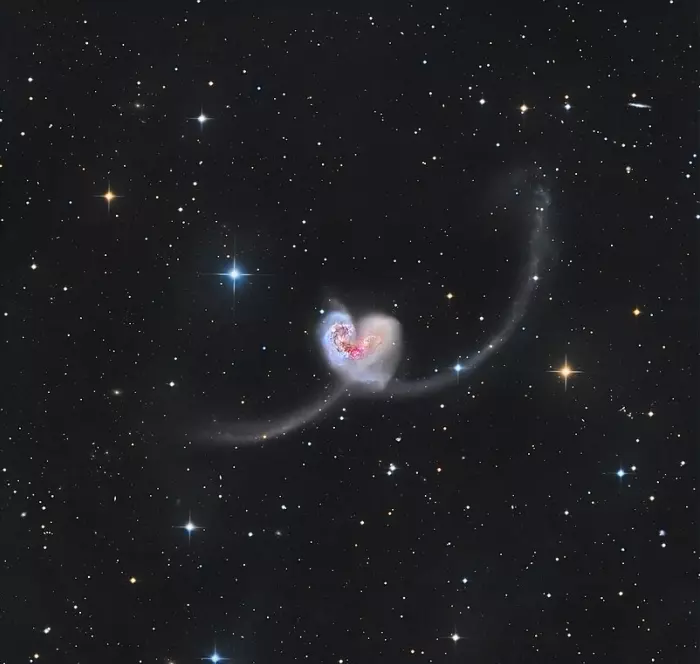
Antennae Galaxies (NGC 4038 and NGC 4039), image credit: Wikimedia Commons/Makrem Larnaout (CC BY-SA 4.0)
Location
The Antennae Galaxies are located in the constellation Corvus. They appear in the same region of the sky as Spica’s Spanker, a quadrilateral asterism formed by the four brightest stars in Corvus (Gienah, Kraz, Algorab, and Minkar). The asterism appears near Spica, the brightest star in the constellation Virgo and the 16th brightest star in the sky.
The galaxies can be found 3.25 degrees southwest of Gienah (Gamma Corvi), the brightest star in Corvus, and only 0.25 degrees north of the fainter 31 Crateris in the neighbouring constellation Crater. They can be seen in a medium-sized telescope on a clear, dark night. Even in a larger telescope they appear like a dim, hazy comma.
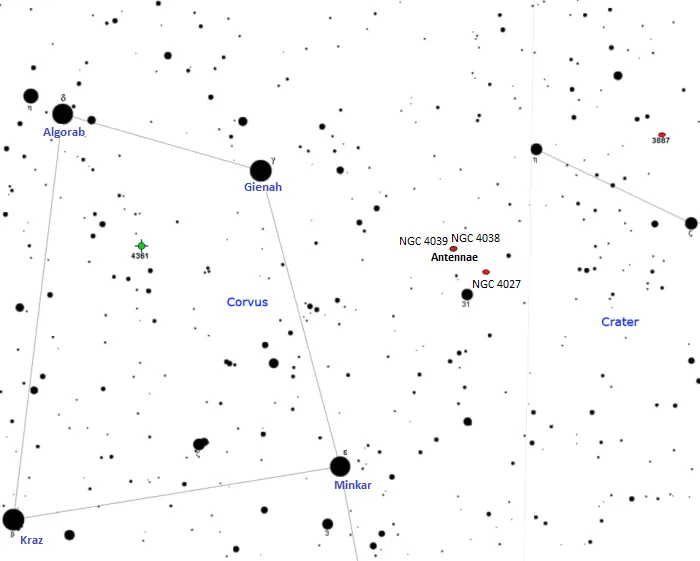
The location of the Antennae Galaxies (NGC 4038 and NGC 4039) in Corvus, image: Roberto Mura (CC BY-SA 3.0)
The best time of the year to observe the Antennae Galaxies and other deep sky objects in Corvus is during the month of May, when the constellation is higher above the horizon in the evening.
Antennae Galaxies – NGC 4038 and NGC 4039
| Constellation | Corvus |
| Right ascension | 12h 01m 53.0s / 12h 01m 53.6s |
| Declination | −18° 52′ 10″ / −18° 53′ 11″ |
| Type | SB(s)m pec / SA(s)m pec |
| Apparent magnitude | 11.2 / 11.1 |
| Apparent size | 5.2′ × 3.1′ / 3.1′ × 1.6′ |
| Size | 500,000 ly (150 kiloparsecs) |
| Distance | 45 million light-years / 65 million light-years |
| Redshift | 1642 ± 12 / 1641 ± 9 km/s |
| Names and designations | Antennae Galaxies, Ringtail Galaxy, NGC 4038 and NGC 4039, Arp 244, Caldwell 60 and Caldwell 61, PGC 37967 and PGC 37969, UGCA 264 and UGCA 265 |